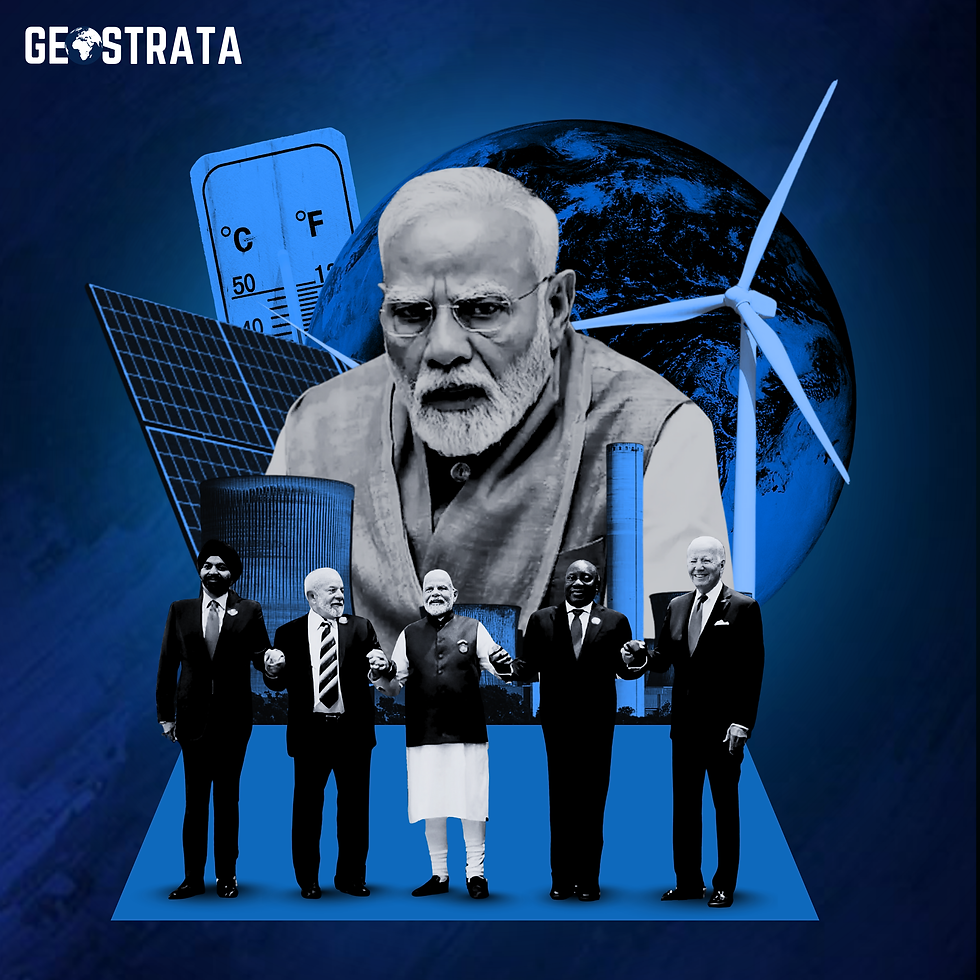Climate Shifts, Power Plays: India’s Climate Diplomacy in a Changing Global Order
- THE GEOSTRATA

- Oct 26
- 5 min read
Updated: Oct 27
In the 21st century, the world has entered a period of dramatic change in global climate dynamics. With an expanding climate crisis, unprecedented temperatures, and evolving geopolitical alignments, India, home to approximately 1.4 billion people and a rapidly developing economy, finds itself at a momentous crossroad.
Illustration by The Geostrata
On the international stage, India’s approach combines its domestic policies with active participation and strategic partnerships, through forums such as the BRICS bloc, G20, COP, and other global platforms for South-South cooperation. As a result, India has emerged as a Global Leader. This article examines India’s approach to international climate justice and negotiations, sustainable development, and its pursuit of an inclusive, multilateral global order.
THE CLIMATE CRISIS
2024 officially became the warmest year on record. For the first time, the global surface temperatures exceeded the 1.5°C threshold above pre-industrial levels set by the Paris Agreement. According to NASA, the average temperature of the planet was 1.47°C warmer than the 19th-century baseline. Similarly, the Copernicus Climate Change Service (C3S) and the World Meteorological Organisation (WMO) also cited a consolidated estimate of 1.55°C. These are some of the many sources that underlie the seriousness of the climate crisis.
Then, there’s India, ranked 7 on the 2024 Climate Change Performance Index, which has made progressive strides, and its Panchamrit commitments are only the next logical steps, such as reaching net-zero by 2070, achieving 50% renewable capacity by 2030 and 47% of its total energy from non-fossil sources. It is now ninth in the world for climate tech venture funding, an indication of growing investor confidence.
Yet, vulnerability remains stark. More than 300 million people living in certain regions across South Asia will be exposed to increasing extreme heat by 2050. This highlights a two-pronged challenge: maintaining the momentum in green growth whilst further absorbing the socioeconomic costs of climate stress in densely populated, poorer areas of the country.
INDIA'S STRATEGIC SHIFT
India’s climate posture reflects a unique diplomatic strategy, anchored in multilateral engagement through UNFCCC, but increasingly diversified via bilateral, mini-lateral, and trilateral tracks. India, using initiatives like the South-South-North Climate Hubs, promotes climate diplomacy that links environmental responsibility with economic leverage.
By Global Climate Equity and the Principle of Common but Differentiated Responsibilities (CBDR), India aims to create fair scales, such as scales of justice. Movements such as BioE3 and circular bio-economy structures are clear indicators of the change toward climate resilience.
Building relations with the International Energy Agency (IEA), adopting the European position on climate economics and thematic R&D, and finally adoption of domestic trading schemes are all part of this model of a just transition that incorporates private finance with a transfer of knowledge.
Additionally, the global demand for modernising multilateral institutions and the objective for private sector-led climate finance by India are some examples of how assertive India is globally. This holistic model of sustainability, innovation, and collaboration makes India a natural frontrunner for climate leadership.
POWER PLAY AT MULTILATERAL FORUMS
During its G20 Presidency and recent COP summits, India positioned itself as a pivotal champion of climate ambition and equity in global forums. Inspired by its traditional sustainable practices, India’s G20 priorities included “Green Development, Climate Finance & LiFE”, which emphasised technology transfer, climate finance for countries still developing, and the Lifestyle and Environment (LiFE) movement.
India led discussions that, for the first time in G20 history, addressed ecological restoration, marine spatial planning, and the circular economy in detail, and it launched the Resource Efficiency and Circular Economy Industry Coalition (RECEIC) to promote industry-led sustainability.
India’s climate diplomacy at the G20 and COP was also marked by advocacy for just energy transitions, ambition on renewables (targeting 500 GW non-fossil capacity by 2030), and supporting the reform of multilateral climate finance systems. India’s approach, balancing development needs with climate leadership, advocated for narrowing global finance gaps, accelerating renewable deployment, and championing just transition principles for the Global South.
At the Conference of Parties (COP) 26, India brought out its updated Nationally Determined Contributions (NDC) and flashed the landmark International Solar Alliance (ISA) and the Coalition for Disaster Resilient Infrastructure (CDRI), which have amplified its climate diplomacy.
The International Solar Alliance (ISA) enables over 100 countries to make the transition to accessible solar energy, facilitating low-cost, clean power for the Global South. Meanwhile, the Coalition for Disaster Resilient Infrastructure (CDRI) mobilises a cohesive approach among governments, agencies, and experts working on climate and disaster risks to ensure that the development of infrastructure is risk-informed and promotes global alignment for standards and innovation.
These actions reflect India’s commitment to its role as a leading developer and bridge between developed and underdeveloped countries.
INDIA'S SOUTH-SOUTH SOLIDARITY AND BRICS
The increasing strength of India’s diplomacy within the BRICS grouping is signified by the unequivocal backing of BRICS member-nations in support of India’s candidacy to host COP33 in 2028, which underscores the faith they repose in India, not only as a country that can help bridge the divide between climate action and development imperatives but also as a country of consequence in climate talks.
Upon assuming the BRICS chair in 2026, India has committed to prioritizing the Global South's interests by utilizing the "humanity first" approach and refashioning BRICS as a resilient, innovative, and sustainable cooperation platform to showcase solutions that can be replicated in other developing regions.
INCLUSIVE CLIMATE GOVERNANCE
India is integrating social equity alongside action to address emerging environmental concerns with inclusivity at the center of the country’s climate governance. The National and State Action Plans on Climate Change goals are aimed at improving climate resilience and capturing the attention of the government with schemes like Pradhan Mantri Surya Ghar Muft Bijli Yojana, which seeks to provide renewable energy to vulnerable populations.
Empowering and equipping officials and vulnerable groups for climate adaptation through education, like the National Institute of Disaster Management and the National Adaptation Fund for Climate Change, is helping build competencies at the local, state, and national levels. All of these undertakings attempt to protect and adapt India’s rising population of 1.4 billion people, alongside the ecosystem, from extreme temperatures and climate risks, and integrate climate risk management across governance.
INDIA'S VISION AND THE ROAD AHEAD
In line with the principle of climate justice, India considers climate action as a growth multiplier but emphasises that it must be sustainable in practice. The government is now moving beyond GDP-centric approaches to economic growth, trying to integrate sustainability metrics like carbon intensity and resource efficiency in development planning.
Some other long-term plans are increasing funding for climate-resilient infrastructure, adaptive agriculture research, and nature-based solutions, including the restoration of mangroves and river ecosystems. However, India still struggles with balancing rapid industrial growth with ecological preservation and is calling for more international climate finance and technology transfer so that its “just transition” can be anchored in equity, economic opportunity, and global solidarity.
BY ANANYA SHUKLA
TEAM GEOSTRATA
.png)








Comments